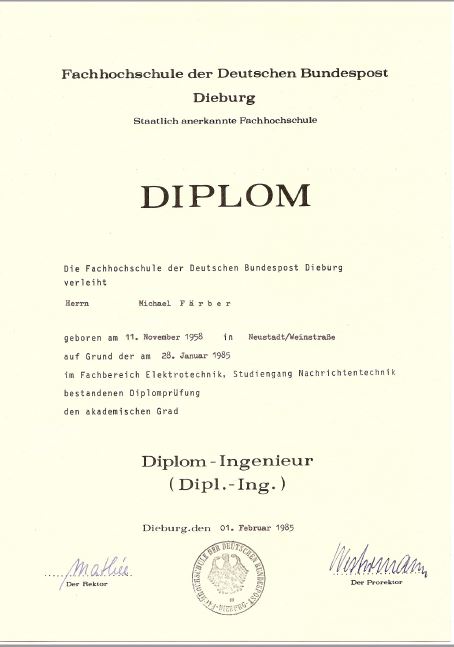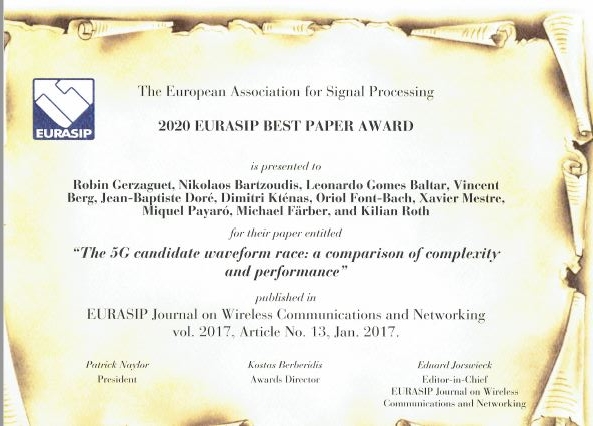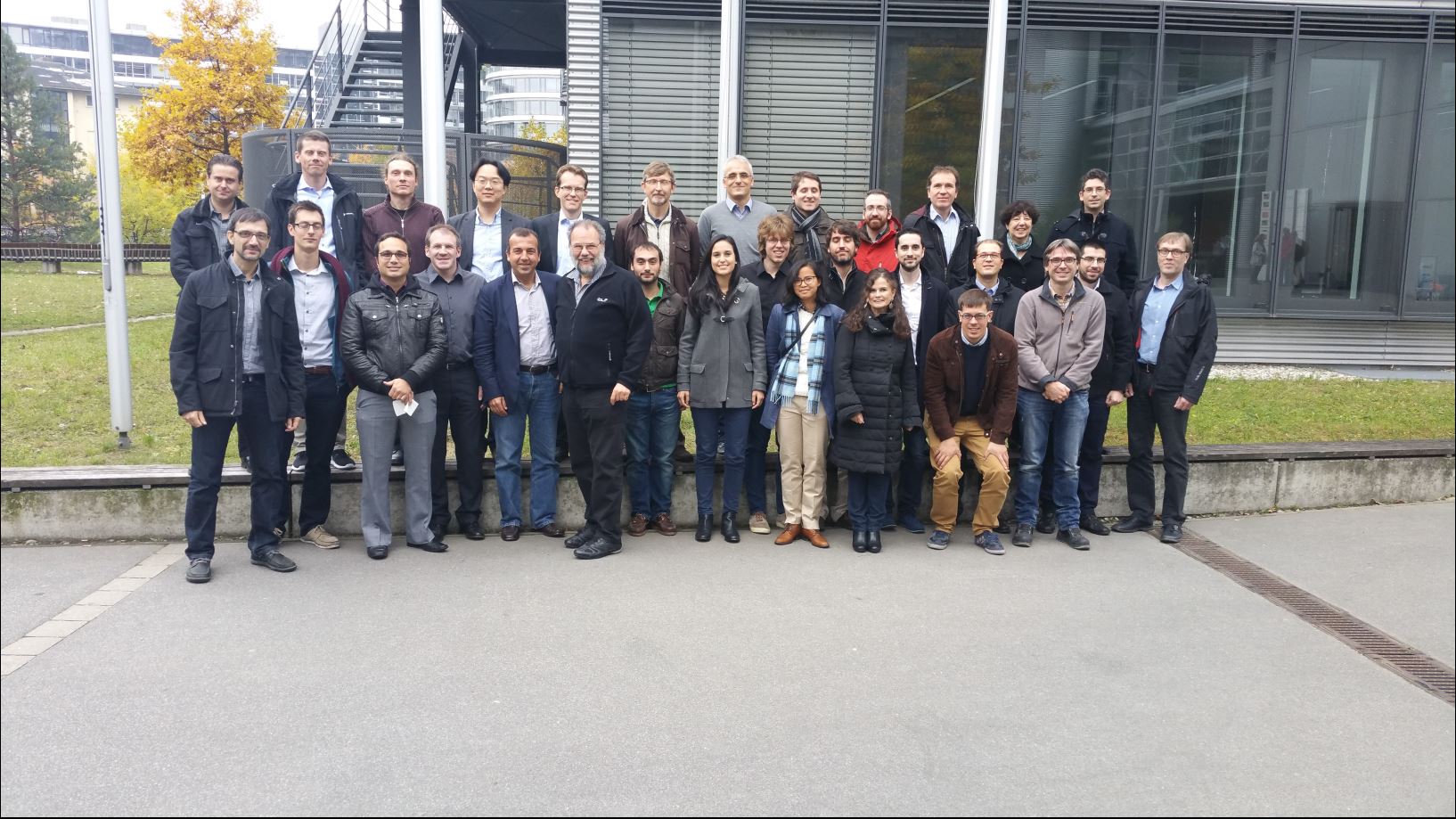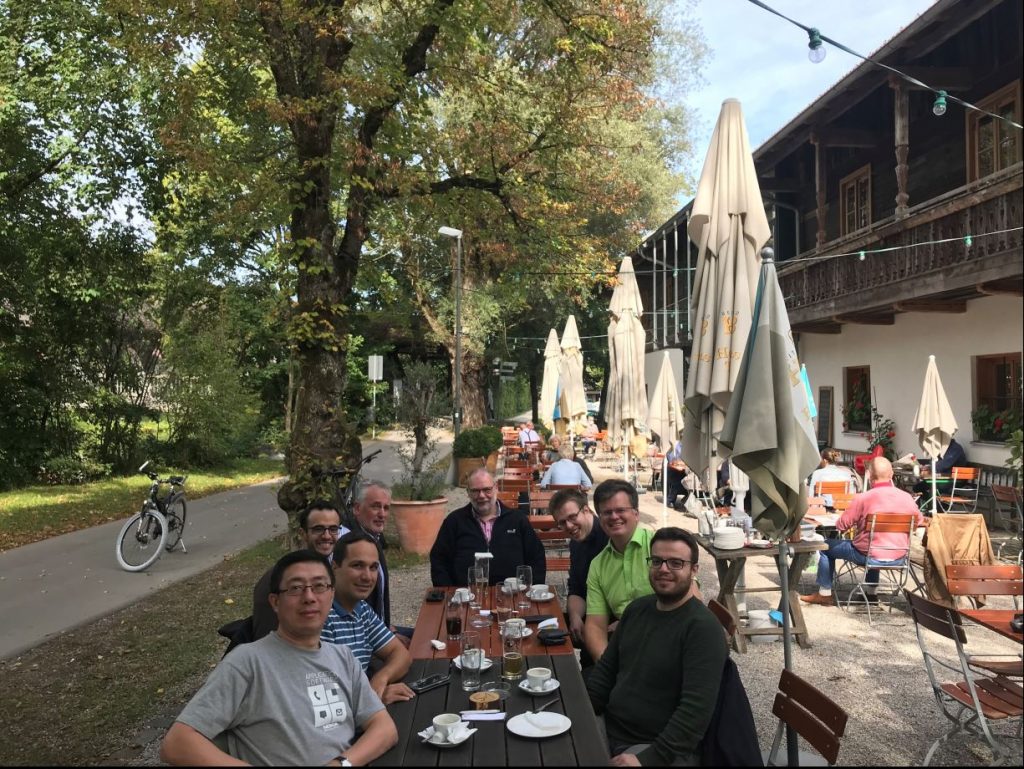In 1975 I started an apprenticeship for getting a Radio- and TV Technician. I successfully received my Certificate of apprenticeship in 1979.

Electronics was an interesting field for me, and I wanted to stay in the field of technology. However I saw as well, that the profession I had learned, will not provide a sustainable future for me. Progress in semiconductors made the Consumer Equipment more durable, in terms of a longer mean time between failure, and there was also a huge price erosion on many devices. Thus I decided to return to school to get a high school grade, and the plan for getting an engineer in electronics.
After my Military service, I visited the Fachhochschule der DBP (University of Applied Schiences), I received my degree (Diplom-Ingenieur) in January 1985.

Just two months later, I joined the Siemens AG in Munich. After a short stunt in µWave technology, dealing with wave guides and antennas, I switched to the Mobile Radio group. Not knowing that this field of technology would be my realm for the rest of my professional life.
My initial work area was in a RF design team, solving design problems for analogue mobile radio. This was for the German C450 Mobile Telephone system, which was that time going from field test to commercial operation. As a rookie I gained a lot of experience in Test bed and system integration work.
Later I was involved in the setup of a GSM prototype equipment, working on Modulator and up-conversion units. This brought me in touch with the GSM phase 1 specifications. The work with these specification, which had been fundamentally in the making that time, raised a lot of questions from my side and brought me closer to standards work.
My focus started to change from pure circuitry design issues, to system engineering tasks, including Radio propagation model analysis, analysis of other competing air interfaces, traffic analysis and network concept work.
I was also involved in a multi-national team, for creating a basic architecture concept for a Siemens Base station product line.
After doing this conceptional work, I joined the research and development team, to gain experience how a concept get transformed to a product.
After the first product release, I entered the product marketing division, to continue my work in the area of standardization, and creation of new features.
Standardization developed to be one of my favorite work areas. I started in 1990 with active participation in the ETSI SMG2 working group. This was in the setup of GSM phase 2, and the creation of DCS 1800 phase 1. Later on, I was also involved in the GPRS concept work in ETSI.
In 1995 I received the honor, to be elected as the vice chairman of the ETSI SMG 2 group. Throughout the year 1998, I chaired the EDGE sub group, dealing with details to extend the GSM data rate capabilities. I stayed with the vice-chair duty until April 2005, i.e. I served 10 years as a vice chairman, first in ETSI and later in 3GPP. This role also enabled me to be part of the 3GPP PCG/OP, the organisational board for managing the 3GPP activities.
ETSI SMG 2 started the work on UMTS (Universal mobile telephone system) in 1996. Since that time, I was also involved in the UMTS work. First promoting the candidate concept from Siemens, known as TD-CDMA.
After the decision of ETSI on the UTRA concept in January 1998, I was involved in the UMTS standardization work. We engaged in both, FDD and TDD transmission modes. The TDD mode which was based on elements of the TD-CDMA concept, was of course an area Siemens was much interested, as this was based on the UMTS candidate technology promoted by Siemens.
ETSI SMG 2 took responsibility for the UTRA concept in setting up 4 Expert groups. This work was continued until end of 1998. In December 1998 the 3GPP (third generation partnership project) was established, which took over the full responsibility in creating the specification for third generation. The goal was the globalisation of the specifications, in combining regional standardization organizations into the project. Today Organizations from Europe, USA, India, Japan, China and South Korea are participating. In December 1999 the first release of specifications was frozen, and released for Product Implementation.
After achieving the UMTS Release 99 milestone, I re-focused on the GSM evolution, also now known as GERAN. These was my main business until 2004, but after more than 10 years in active standardization, I wanted to broaden my scope, and started to to build up knowledge on innovation methods, and on research topics which may later get standards relevant.
This was leading to an involvement in the early LTE considerations, and together with my team we worked on fundamental topics for this new standard. Instead of traveling frequently to the meetings as such, my team worked in the back-office, doing a lot of concept and simulation work, for the standards team.
In 2007 Siemens merged with Nokia the mobile Network divisions, which resulted in the Nokia Siemens Networks company, which was later renamed simply to Nokia. Roles and tasks had to be newly organized, and I took initially responsibility for the HSPA evolution (3G+) track. In parallel I started to engage with my team also in EU funded research projects. Over the time, this was gaining more momentum as the HSPA evolution, and involvement in the pre-standards work for LTE-Advanced, especially in being part of the EU funded project ARTIST4G, and having the role of a work package leader in the project.
In 2012 I decided to leave Nokia and joining Intel in Germany on its Neubiberg site, which is very close to Munich. After more than 25 years working on mobile radio infrastructure, it was exciting now to work on mobile radio chip sets for consumer devices. This brought me back into an active role in 3GPP Standardization.
In parallel the technical discussions on 5G started, and the EU started the Horizons2020 program, which contained also a branch for 5G and its evolution. As the discussions started how to create an efficient %G resesearch environment in the Horizon2020 program, I involved in two mm-Wave projects, happening in the final phase of the EU Frame program 7. This was MiWaves, with a higher involvement from my side, and MIWEBA with a lower involvement from my side.
5G Research was than decided to be coordinated in a public/private Partnership project, between the EU commission and the Industry. This led to the creation of the 5G-PPP. I followed these developments and Intel engaged as well in this 5G-PPP organization. I received the task to involve into promising project proposals in the phase 1 of the H2020 program. For this I got headcount and was able to built up a new team. The proposals we selected had been highly successful in the project selection process, and all 4 projects we selected received a grant by the EU. (Flex5Gware, Fantastic-5G, mmMagic, Metis-II)

In one project I also assumed the role as a project coordinator (Flex5Gware), orchestrating 17 partners from Industry and Academia. These projects had a duration of two years, and we also engaged in the follow up phase, but on a smaller foot print.


5G had received a very strong momentum in standardization, and first standards release was quickly created by a very high number of contributors. 5G contains a high potential to change communication in other vertical industries. My team was therefore engaging in the Areas of Automotive and Industry Automation. Thus, I started engaging with my team, in Organizations like 5GAA and 5G-ACIA, where I personally served as board member in both of these organizations.
In 2021 I entered the path to retirement, and I left Intel. After 36 years as an engineer, and after 46 years when I started my first professional education, I felt that this is enough, there is not too much where I can go. Further, it was also time to let younger team mates gaining responsibilities.

I am still proud of my work in the industry and being an engineer. Now I am retired engineer, but with the spirit of an engineer, I will stay for the rest of my life.